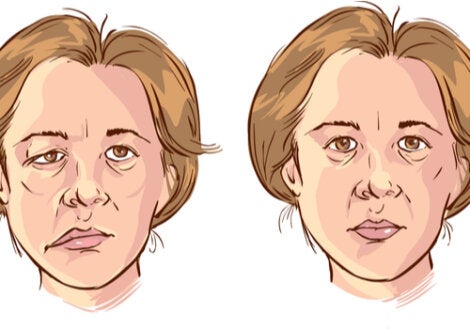Facial Paralysis: Causes and Treatments

Facial expressions are a fundamental part of appropriate social interactions. They’re also very important for correctly interpreting other people’s emotions. Consequently, people with facial paralysis can have problems with social interaction as well as emotional recognition.
Studies show that facial expressions are innate and universal behavior patterns. Researchers have proven this by doing experiments that compare the facial expressions of blind children and children with normal vision and with transcultural studies, among others.
Scientists found that facial expressions were very similar across different groups. In addition, individuals didn’t have any problems recognizing the facial expressions of people from other groups.
You express emotion and feign particular facial expressions that correspond to certain emotions using the muscles in your face. Facial movements are controlled by two independent circuits. Whether what you want to express is genuine or fake determines which circuit your brain activates.

Emotional facial palsy
This kind of paralysis is due to an injury in the insular region, the white matter of the frontal lobe, or the thalamus and left hemisphere areas of the brain. This system is associated with the physical architecture responsible for the voluntary movements of facial muscles. It connects to the medulla oblongata and the caudal region of the protuberance.
Damage to this system leads to an inability to express genuine emotions on the side of the body opposite to the injury. In this case, that would be the right side of the face.
However, people with this kind of paralysis are perfectly capable of reproducing (or faking) any kind of facial expression on both sides of their face.
Volitional facial paralysis
Individuals with volitional facial paralysis can’t move their facial muscles when they’re trying to fake emotion. The side of the face that’s contralateral to the injury doesn’t respond to the brain’s signal to make a particular facial expression.
When emotion is genuine, however, the facial muscles on both sides of the face respond normally. Individuals with volitional facial paralysis are incapable of correctly faking an emotion that they don’t actually feel.
Injury to the right hemisphere, primary the motor cortex, is what causes this injury. Specifically, the area that corresponds to the face. Damage to the fibers that connect the frontal region to the facial motor muscle can also cause this issue (also in the right hemisphere).
The ability to mimic other’s emotions and feedback of your own facial expression is what allows you to put yourself in other people’s shoes, recognize their emotions, and respond appropriately.
A neuroimaging study showed that observation and imitation of emotional expressions trigger an increase in the activity of the frontal area of mirror neurons. That leads to more empathetic behavior and better relationships with other people.
In any case, the fact that the ability to reproduce other peoples’ facial expressions helps with emotional recognition doesn’t mean that people with facial paralysis are completely incapable of doing so. It simply means they might have more trouble than most.
The role of facial expressions in emotional recognition
As you know, emotional expression allows you to communicate with the world around you. Nevertheless, this function only makes sense if other people are able to comprehend that emotional state and respond appropriately to it.
The right hemisphere is more related to emotional recognition than the left brain. As a result, people with injuries to the right brain have a hard time with emotional recognition.
Several areas of the brain are involved in emotional recognition, such as the amygdala, the prefrontal cortex, mirror neurons, etc. However, we’re going to focus on mirror neurons and the role that imitation plays in emotional recognition.
When you see another person’s emotional expression, your brain automatically, unconsciously, and imperceptibly reproduces that emotion.
Seeing facial expressions in others activates your mirror neurons, and they allow you to imitate those expressions. The feedback that happens when you imitate a facial expression is what allows you to understand how other people are feeling and empathize with them.
In addition to volitional facial paralysis, there’s another kind of facial paralysis. This one in particular demonstrates the relationship between emotional expression and recognition. It’s called Moebius syndrome. This paralysis also affects emotional facial expression and emotional recognition.
“Comfort in expressing your emotions will allow you to share the best of yourself with others, but not being able to control your emotions will reveal your worst.”
-Bryant H. McGill-

How facial paralysis affects lives
Facial expression allows you to engage in non-verbal communication, which enriches the words that you say.
Interpreting other people’s facial expressions also allows you to infer their needs or desires. That often happens before you can figure them out through other channels. Facial expressions, in other words, make us the most intelligent beings on the social plane.
If you’re unable to recognize facial expressions of those around you, it can make relationships very difficult. Not only that, but the inability or difficulty with correctly expressing what you feel is a challenge for everyone around you.
Luckily, there are other means of communication available, even for people with facial paralysis. There’s verbal language, of course, and alternate forms of non-verbal expression. Imitation and prosody can also help compensate for problems due to facial paralysis.
https://lamenteesmaravillosa.com/paralisis-facial-cuando-el-rostro-no-responde/
Facial expressions are a fundamental part of appropriate social interactions. They’re also very important for correctly interpreting other people’s emotions. Consequently, people with facial paralysis can have problems with social interaction as well as emotional recognition.
Studies show that facial expressions are innate and universal behavior patterns. Researchers have proven this by doing experiments that compare the facial expressions of blind children and children with normal vision and with transcultural studies, among others.
Scientists found that facial expressions were very similar across different groups. In addition, individuals didn’t have any problems recognizing the facial expressions of people from other groups.
You express emotion and feign particular facial expressions that correspond to certain emotions using the muscles in your face. Facial movements are controlled by two independent circuits. Whether what you want to express is genuine or fake determines which circuit your brain activates.

Emotional facial palsy
This kind of paralysis is due to an injury in the insular region, the white matter of the frontal lobe, or the thalamus and left hemisphere areas of the brain. This system is associated with the physical architecture responsible for the voluntary movements of facial muscles. It connects to the medulla oblongata and the caudal region of the protuberance.
Damage to this system leads to an inability to express genuine emotions on the side of the body opposite to the injury. In this case, that would be the right side of the face.
However, people with this kind of paralysis are perfectly capable of reproducing (or faking) any kind of facial expression on both sides of their face.
Volitional facial paralysis
Individuals with volitional facial paralysis can’t move their facial muscles when they’re trying to fake emotion. The side of the face that’s contralateral to the injury doesn’t respond to the brain’s signal to make a particular facial expression.
When emotion is genuine, however, the facial muscles on both sides of the face respond normally. Individuals with volitional facial paralysis are incapable of correctly faking an emotion that they don’t actually feel.
Injury to the right hemisphere, primary the motor cortex, is what causes this injury. Specifically, the area that corresponds to the face. Damage to the fibers that connect the frontal region to the facial motor muscle can also cause this issue (also in the right hemisphere).
The ability to mimic other’s emotions and feedback of your own facial expression is what allows you to put yourself in other people’s shoes, recognize their emotions, and respond appropriately.
A neuroimaging study showed that observation and imitation of emotional expressions trigger an increase in the activity of the frontal area of mirror neurons. That leads to more empathetic behavior and better relationships with other people.
In any case, the fact that the ability to reproduce other peoples’ facial expressions helps with emotional recognition doesn’t mean that people with facial paralysis are completely incapable of doing so. It simply means they might have more trouble than most.
The role of facial expressions in emotional recognition
As you know, emotional expression allows you to communicate with the world around you. Nevertheless, this function only makes sense if other people are able to comprehend that emotional state and respond appropriately to it.
The right hemisphere is more related to emotional recognition than the left brain. As a result, people with injuries to the right brain have a hard time with emotional recognition.
Several areas of the brain are involved in emotional recognition, such as the amygdala, the prefrontal cortex, mirror neurons, etc. However, we’re going to focus on mirror neurons and the role that imitation plays in emotional recognition.
When you see another person’s emotional expression, your brain automatically, unconsciously, and imperceptibly reproduces that emotion.
Seeing facial expressions in others activates your mirror neurons, and they allow you to imitate those expressions. The feedback that happens when you imitate a facial expression is what allows you to understand how other people are feeling and empathize with them.
In addition to volitional facial paralysis, there’s another kind of facial paralysis. This one in particular demonstrates the relationship between emotional expression and recognition. It’s called Moebius syndrome. This paralysis also affects emotional facial expression and emotional recognition.
“Comfort in expressing your emotions will allow you to share the best of yourself with others, but not being able to control your emotions will reveal your worst.”
-Bryant H. McGill-

How facial paralysis affects lives
Facial expression allows you to engage in non-verbal communication, which enriches the words that you say.
Interpreting other people’s facial expressions also allows you to infer their needs or desires. That often happens before you can figure them out through other channels. Facial expressions, in other words, make us the most intelligent beings on the social plane.
If you’re unable to recognize facial expressions of those around you, it can make relationships very difficult. Not only that, but the inability or difficulty with correctly expressing what you feel is a challenge for everyone around you.
Luckily, there are other means of communication available, even for people with facial paralysis. There’s verbal language, of course, and alternate forms of non-verbal expression. Imitation and prosody can also help compensate for problems due to facial paralysis.
https://lamenteesmaravillosa.com/paralisis-facial-cuando-el-rostro-no-responde/
All cited sources were thoroughly reviewed by our team to ensure their quality, reliability, currency, and validity. The bibliography of this article was considered reliable and of academic or scientific accuracy.
Carlson, N. R., & Clark, D. P. (2014). Fisiología de la conducta. Madrid, Spain:: Pearson Educación.
This text is provided for informational purposes only and does not replace consultation with a professional. If in doubt, consult your specialist.







